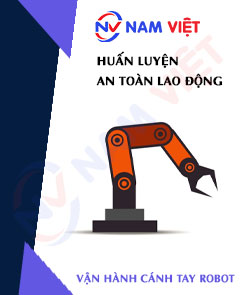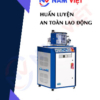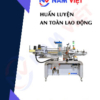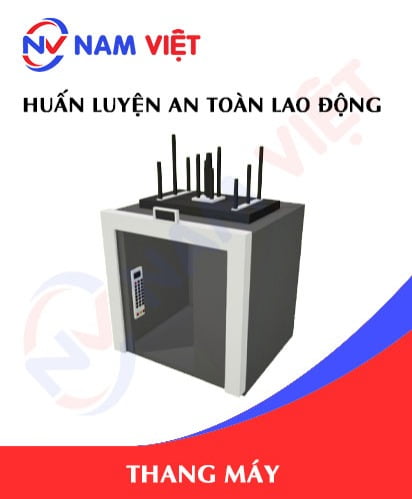Occupational Safety Training for Operating Robot Arms
99,000 ₫
Note: The above price is calculated per person and may vary depending on the number of participants in the course and market fluctuations. For more accurate pricing information, please refer to the pricing list or contact our consultants directly.
Occupational safety is an important issue when operating robot arms and needs to be addressed promptly to ensure the health and safety of workers and to enhance the reputation of businesses here. The Occupational Safety Training course is one of the effective solutions to raise awareness on accident prevention for workers operating robot arms.
Table of Contents
Toggle1. Overview of Robot Arms
a. What is a Robot Arm?
A robot arm is an automated device shaped and functioning similarly to a human arm but designed to perform automatic or semi-automatic tasks in industrial or research environments. Robot arms are commonly used in various applications, from assembly and material handling on production lines to performing precise surgeries in the medical field.
Main Components of a Robot Arm
- Links and Joints: A robot arm typically consists of connected segments that can move in different directions. The joints can be rotary joints or prismatic joints, allowing flexible movements.
- Motors and Control System: Motors control the arm’s movements by adjusting the position and angles of the joints. The control system manages sensor signals and executes commands to operate the arm.
- Sensors: Sensors help the robot arm perceive its surroundings and operating status. They can measure force, position, and other parameters essential for precise control.
- End Effectors: The end part of the robot arm, called grippers or attached tools, performs specific tasks such as gripping, assembling, welding, or surgery.

b. Operating Principle of Robot Arms
Input
The robot arm starts by receiving information from control sources, which may come from:
- Operator: Commands entered via control panels, computers, or remote control devices.
- Sensors: Sensors mounted on the robot arm provide data about position, applied force, or the environment.
Signal Processing
Input signals are sent to the robot arm’s control system, which typically includes:
- Controller: The controller analyzes inputs and determines necessary actions. It may be a microprocessor or digital signal processor (DSP) running pre-programmed control software.
- Control Algorithms: Algorithms such as PID (Proportional-Integral-Derivative) adjust signals to achieve precise position and force.
Motion Control
After processing, the control system sends commands to the arm’s moving parts:
- Motors: Motors execute the required movements, adjusting joint positions. These can be stepper motors, servo motors, or DC motors.
- Actuators: Actuators transmit motion from motors to joints and links of the robot arm.
Kinematic Motion
- Kinematics: Study of joint and link motion without considering forces. The robot arm uses kinematic equations to calculate necessary movements to reach desired positions.
- Inverse Kinematics: Sometimes used to calculate joint angles needed to place the tool at a specific location.
Task Execution
Once positioned accurately, the robot arm performs programmed tasks, which may include:
- Gripping and Material Handling: Using tools or grippers to pick up, move, or assemble materials.
- Surgery or Research: Performing precise tasks in medical or research environments.
Feedback and Adjustment
- Feedback Sensors: Continuously monitor the robot arm’s status, providing feedback on position, force, and other parameters.
- Adjustment: Based on feedback, the control system adjusts commands to ensure accurate task performance.
Interaction and Automation
- Human Interaction: Some robot arms are designed to interact directly with humans, featuring safety mechanisms and human-machine interfaces.
- Automation: Robot arms can operate fully automatically, performing repetitive cycles without human intervention.

c. Industries Using Robot Arms
Manufacturing Industry
- Assembly: Robot arms are used in assembly lines to combine parts and products, performing tasks like screwing, installing components, and quality inspection.
- Welding: In manufacturing and automotive industries, robot arms perform automated welding tasks such as arc welding and spot welding to ensure precision and consistency.
- Painting: Painting robots apply coatings evenly and with high quality, commonly used in automotive and furniture production.
Automotive Industry
- Component Assembly: Robot arms play key roles in assembling car parts, including electronics, drivetrain systems, and mechanical components.
- Inspection and Measurement: Robots equipped with sensors check and measure car parts to ensure product quality.
Electronics Industry
- PCB Assembly: Robot arms assemble electronic components on circuit boards, place chips, and perform other precise tasks.
- Quality Inspection: Robots conduct quality checks from connection integrity to functional tests.
Healthcare Industry
- Surgery: Medical robot arms assist doctors in performing precise and minimally invasive surgeries, such as the da Vinci surgical robot.
- Patient Care: Robots assist patients with simple tasks like medication delivery or mobility support.
Food and Beverage Industry
- Processing and Packaging: Robot arms handle, package, and inspect food and beverage products to improve efficiency and hygiene.
- Sorting and Automation: Robots help sort food products and automate processing and packaging workflows.
Pharmaceutical Industry
- Manufacturing and Packaging: Robots are used to produce and package medicines with precision and reduce contamination risks.
- Research and Development: Robot arms support drug research and development by performing automated experiments and data analysis.
Research and Development
- Science and Technology: Robot arms are used in scientific research to perform complex experiments, adjust instruments, and collect data.
- Manufacturing and Refining Equipment: In labs and research facilities, robots help manufacture and calibrate research devices.
Transportation and Logistics
- Material Handling: Robot arms handle, sort, and load/unload goods in warehouses and distribution centers.
- Warehouse Automation: Robots automate warehouse processes, including moving goods and managing inventory.
Construction Industry
- Building and Deploying Structures: Robots assist in building complex structures and performing tasks in challenging or hazardous construction environments.
2. Overview of Safety Training for Operating Robot Arms
a. What is Occupational Safety Training?
- Occupational safety training for operating robot arms consists of sessions that raise awareness on accident prevention for workers. Those working directly with robot arms belong to Group 3.
- The training course helps workers recognize and avoid hazards, reducing the risk of workplace accidents.
REGISTER FOR OCCUPATIONAL SAFETY TRAINING SERVICE
b. Training Duration
Initial Safety Training Duration
- Total training time must be at least 24 hours, including examination time.
- 8 hours of theory on occupational safety policies and laws
- 8 hours of theory on basic occupational safety knowledge
- 4 hours of theory on specialized training content
- 2 hours of practical training on specialized content
- 2 hours of final theoretical exam
The safety training center will schedule multiple sessions depending on workers’ availability. Usually, there are 6 training sessions over 3 days, provided the manufacturing enterprise can arrange continuous training time.
Periodic Safety Training Duration
- Before the occupational safety card expires, workers who wish to renew must attend periodic occupational safety training with a training duration of at least 50% of the initial training duration.
Explanation: the total periodic occupational safety training time must be at least 12 hours, including examination time. After successfully completing the periodic training and passing the exam, workers will be reissued or have their occupational safety card extended.
c. Training Content
| No. | TRAINING CONTENT | TRAINING DURATION (HOURS) | |||
| Total | Including | ||||
| Theory | Practice | Examination | |||
| I | Occupational safety policies and laws | 8 | 8 | 0 | 0 |
| 1 | Overview of the occupational safety legal document system. | 6 | 6 | ||
| 2 | Standards and technical regulations on occupational safety and hygiene. | 1 | 1 | ||
| 3 | Specific regulations of state management agencies on occupational safety when building, expanding, or renovating production facilities and managing machinery, equipment, materials, and substances with strict occupational safety requirements. | 1 | 1 | ||
| II | Basic knowledge of occupational safety and hygiene | 8 | 8 | 0 | 0 |
| 1 | Basic knowledge of hazards and harmful factors at the workplace. | 4 | 4 | ||
| 2 | Methods to improve working conditions. | 1 | 1 | ||
| 3 | Safety culture in production and business. | 1 | 1 | ||
| 4 | Rights and obligations of employers and employees; policies and regimes on occupational safety for employees; functions and duties of safety network and hygiene staff. | 1 | 1 | ||
| 5 | Safety and hygiene regulations, safety signs, instructions on safety and hygiene, use of safety equipment and personal protective equipment; first aid skills for workplace accidents and occupational disease prevention. | 1 | 1 | ||
| III | Specialized training content | 6 | 4 | 2 | 0 |
| Comprehensive knowledge of machinery, equipment, and substances that generate hazardous factors; risk analysis, evaluation, and management of occupational safety; safe working procedures with machinery, equipment, and substances with strict safety requirements. | 6 | 4 | 2 | ||
| IV | Final safety training examination | 2 | 2 | 0 | 0 |
| Total | 24 | 22 | 2 | ||
See more training content for the 6 groups
d. Occupational Safety Card
After completing the occupational safety training and passing the examination, workers will be issued an occupational safety card (commonly called the occupational safety certificate for Group 3).
The Group 3 safety card clearly shows information such as full name, date of birth, specific job and working environment, training duration, official stamp, and signature confirming completion of the training course.
According to regulations on card issuance stated in Clause 2 of Article 24 of Decree 44/2016/ND-CP, there are two cases:
- If the employer and employee have a labor contract, the employer must stamp and endorse the safety card after the employee completes training and passes the exam.
- If the worker is freelance or temporary and does not have a labor contract, the training unit must stamp and endorse the safety card after training and passing the exam.

3. Hazards for Workers When Operating Robot Arms
Collision and Physical Injury
- Collision risk: Robot arms can move quickly and powerfully, posing dangers if they collide with workers or other objects in the work area.
- Physical injuries: Collisions may cause serious injuries such as broken bones, soft tissue wounds, or other harm.
Electrical and Mechanical Risks
- High voltage: Robot arms are usually equipped with motors and control systems operating at high voltage, posing the risk of electric shock.
- Mechanical failure: Mechanical parts such as motors and joints can malfunction or break, leading to accident risks.
Risks from Software or Control
- Software errors: Errors in control software may cause unintended robot arm actions, resulting in accidents or damage.
- Programming flaws: Incorrect programming can cause the robot to perform inaccurate or dangerous tasks.
Risks from Automation and Operating Range
- Automation: Automated systems may cause risks if not properly monitored and managed.
- Operating range: Robot arms can operate within a wide area, posing risks if safety limits are not set.
Risks from Communication and Interaction
- Poor communication: Lack of clear communication between workers and the robot system can lead to misunderstandings and accidents.
- Unsafe interaction: Workers may inadvertently interfere with robot arm operations without realizing the danger.
Risks from Environmental Impacts
- High or low temperatures: Robot arms may operate in environments with extreme temperatures, posing risks to workers.
- Hazardous materials: Some robot arms are used in environments with hazardous materials, such as toxic chemicals or dust.

4. Measures to Control Occupational Accidents When Operating Robot Arms
Design and Installation of Safety Systems
- Barriers and Safety Zones: Build fences or safety zones around robot arms to prevent workers from approaching while the robot is operating.
- Restricted Areas: Set up systems to limit the robot’s working area to ensure its movements do not exceed safe zones.
Sensors and Warning Systems
- Human Detection Sensors: Use sensors (such as infrared or ultrasonic) to stop or adjust the robot’s operation if a worker is nearby.
- Warning Systems: Install warning lights or sounds to notify workers when the robot is operating or when potential hazards exist.
Training and Instruction
- Safety Training: Provide comprehensive training to workers on safe robot operation, hazard recognition, and emergency response.
- Programming Training: Ensure robot programmers have sufficient knowledge to program safely and accurately to avoid software errors.
Maintenance and Periodic Inspection
- Regular Maintenance: Conduct regular maintenance and inspections of mechanical and electrical components to ensure proper function and safety.
- Safety System Checks: Verify that safety systems such as sensors and fences operate correctly.
Establishing Safe Work Procedures
- Operation Procedures: Develop detailed operation procedures for tasks involving robot arms, including startup, operation, and shutdown steps.
- Emergency Procedures: Provide guidance on handling emergencies such as robot malfunctions, safety incidents, or medical emergencies.
Personal Protection and Protective Equipment
- Personal Protective Equipment (PPE): Provide protective gear such as gloves, safety glasses, and protective clothing as needed for workers.
- Protective Sensors: Ensure protective devices and sensors are integrated and maintained in good working order.
Management and Monitoring
- Continuous Monitoring: Monitor robot arm operations continuously to detect and handle issues or risks promptly.
- Risk Management: Assess and manage risks related to robot arm operation, implementing preventive measures and continuous improvement.
Review and Update Safety Policies
- Policy Evaluation: Regularly review and update safety policies based on practical experience and past incidents.
- Regulatory Compliance: Ensure robot arm operations comply with current occupational safety laws and standards.
Enhancing Communication and Interaction
- Clear Communication: Ensure clear communication between operators, programmers, and stakeholders to coordinate safely when working with robot arms.
- Safe Interaction: Establish safe interaction procedures for workers intervening in robot operations, such as during repairs or maintenance.
5. Benefits of Occupational Safety Training
An Toàn Nam Việt offers your business the following great benefits after completing occupational safety training courses according to Decree 44/2016/NĐ-CP on occupational safety and hygiene. Companies and enterprises can:
- Enable workers to identify potential accident hazards and take preventive measures to avoid workplace accidents.
- Help businesses establish risk prevention measures in production, operation, and maintenance processes.
- Reduce costs related to workplace safety risks.
- Maintain uninterrupted production, improving labor productivity and product quality.
- Comply with occupational safety laws to avoid legal risks.
- Build credibility and professionalism, thereby enhancing the company’s brand.
Nam Việt’s training courses are solutions to prevent external factors from affecting individuals, helping them avoid dangers that can cause injuries or even death.
REGISTER FOR OCCUPATIONAL SAFETY TRAINING SERVICES
6. Customer Feedback After Completing Training
An Toàn Nam Việt has many years of experience partnering with various businesses in Vietnam in general and southern provinces in particular. This responsibility is precious to Nam Việt, so our Occupational Safety Training is increasingly professional. The motivation behind An Toàn Nam Việt’s growth comes from positive feedback and suggestions from clients. Below are some testimonials from our partners.
Hoa Đất Construction and Trading Joint Stock Company
“Nam Việt’s service helped us a lot in simplifying occupational safety and completing safety documents for working processes. The consulting staff were enthusiastic and timely in answering our questions. 5 stars for Nam Việt.”
See more customer interviews after using An Toàn Nam Việt services
7. An Toàn Nam Việt’s Capacity for Occupational Safety Training
An Toàn Nam Việt is a reputable and quality occupational safety training center in Vietnam. Training sessions are continuously held at factories, plants, and construction sites nationwide (in all 63 provinces).
REGISTER FOR OCCUPATIONAL SAFETY TRAINING SERVICES
Occupational Safety Training License
- An Toàn Nam Việt has been inspected and certified by the Department of Safety under the Ministry of Labor – Invalids and Social Affairs, confirming our eligibility to conduct occupational safety and hygiene training. This further strengthens our training capacity.

Materials and Lectures
- Before use in occupational safety training courses, materials are reviewed to ensure accuracy and effectiveness.
- Teaching methods are standardized per An Toàn Nam Việt’s guidelines, developed by experts to maximize knowledge absorption.
Facilities
- Controlling classroom conditions enhances teaching effectiveness and student learning.
- Our training facilities include spacious classrooms meeting standards for size, lighting, and training equipment.
8. Nationwide Reputable Quality Training Center
At An Toàn Nam Việt, we put occupational safety training as our top professional priority. For us, imparting self-protection knowledge to workers to ensure their safety in livelihood is contributing to national development.
To ensure training effectiveness, we meticulously prepare everything, from tools, teaching equipment to curricula, materials, sound, and lighting.
Our instructors are experts with many years of experience and research on hazard identification and prevention across industries.
Their lectures are practical, vivid, and easy for workers to understand, ensuring comfort during learning and good knowledge absorption. All content complies with Decree 44/2016/NĐ-CP.
Workers thus learn many prevention measures and how to protect themselves, applying them suitably in real work.
Our training center proudly provides reputable, professional occupational safety training with advantages:
- Competitive training costs with guaranteed quality.
- Flexible training schedules matching company production.
- Fast, compliant certification procedures.
- Experienced instructors.
- Controlled classroom environment for improved learning.
- Tailored training content for company occupational safety.
- Dedicated, professional service for prompt customer support.

9. Additional Occupational Safety Training Materials
- Occupational safety materials for robot arm operation
- Complete occupational safety training materials
- Occupational safety training test sets
- Occupational safety training curriculum for robot arm operation
- Occupational safety multiple-choice test for robot arm operation
No comments yet















Review Occupational Safety Training for Operating Robot Arms
There are no reviews yet.